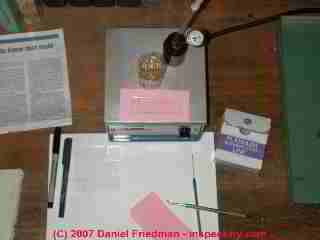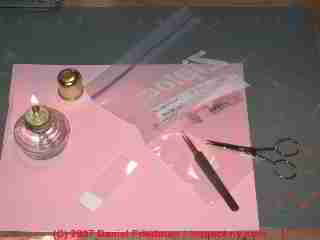 How to Prepare Cargille Meltmount™ slides for rapid field or laboratory use
How to Prepare Cargille Meltmount™ slides for rapid field or laboratory use
How to prepare permanent microscope slide mounts
- POST a QUESTION or COMMENT about making permanent microscope slide mounts
This lab procedure describes a method for preparing permanent microscope slide mounts using Cargille's MeltMount.
We use this method when preparing particle samples which are to be retained indefinitely, such as for reference slides or where the samples may be required in environmental or mold litigation. - (Photographs are available -To Be Added or on request).
InspectAPedia tolerates no conflicts of interest. We have no relationship with advertisers, products, or services discussed at this website.
Materials., Methods & Procedures to Prepare Permanent-Mount Microscope Slides

Required materials for permanent mount microscope slide preparation using Cargille Meltmount
- Cargille Meltmount - Cargille Laboratories www.cargille.com or from secondary suppliers such as www.2spi.com permanent slide mounting media (replacement for Canada Balsam and Aroclor) ND=1.539 @25degC.
- Hot plate, Slides, Colored paper, Needle, dropper, or implement for mountant transfer to slide.
- Detailed instructions available from Cargille regarding slide preparation using Meltmount. Remember to work in a well-ventilated area, to be careful of hot surfaces and chemicals, and to wear polyethylene gloves to avoid getting solvents or mountant on skin surfaces.
For in-lab use Cargille describes a procedure for sample preparation in which the sample is placed on the slide, the cover slip installed, and meltmount is introduced to the corners of the cover slip using a dropper.
Cargille also describes a method of pre-coating slides with mountant for subsequent use in the field.
Because the container of Meltmount, as received from Cargille takes some time to heat completely for in-lab use, and because I work with a variety of field sample materials which can be slow following this routine, I have adapted Cargille's "Pressure method," intended for field use, to a combination of lab and field work as I describe below.
- Cut out colored paper to approximately 2" x 4" and place a piece on the hot plate. The paper will be used to provide added contrast to enable easy view of the area of the slide which has been coated with mountant. Draw on the paper an outline of one of your slides and then mark within
that outline the area where you will ultimately want to place a cover slip on the slide.
This permits production of uniform slides and speed work at the microscope by placing each sample in the same area on the microscope stage. Prepare several of these colored slips so that you can replace them when soiled or wet. - Heat the mountant to the proper working temperature. Heat surface to 60-70 C - the meltmount will be liquid but not smoking if it's at the easiest working temperature. I heat the meltmount in its container to a lower temperature
- Place the colored, marked paper on the hot plate.
- Place the slide on the colored paper over the outlined area.
- Pick up a droplet of Cargille permanent slide mountant with your implement of choice. I use a dental tool to pick up a droplet of mountant, let it solidify on the end of the tool (takes only a second), then I use the melted drop on the tool to "paint" the target area on the slide as described below. Too much mountant may produce a messy slide with a lot of excess mountant to be cleaned off later. Too little mountant may not adequately handle large particles, leaving a tilted cover slip.
- When the slide has been "painted" with mountant move it to another area of the hot plate where it should remain until the mountant has been heated to a level, uniform state. Meanwhile you can be working on coating subsequent slides.
- When the mountant is level on the slide remove the slide to a cool, not cold, surface and let the slide cool to room temperature.
- Label the slide with blank labels at this stage to make it easy later to quickly see which side has the mountant.
- Store prepared microscope slides flat, mountant upright. I use a plastic slide box.
To use previously prepared Cargille Meltmount slides in the field or lab.

- Transfer the sample to the area of mountant either by scraping the sample on to the slide, transferring by tape, or other method.
- Heat the slide briefly over a match or alcohol lamp.
- Install the cover slip.
- Permit the slide to stabilize: Cargille recommends pressing the slide between waxed paper and weighted by a book overnight. When I used an alcohol lamp to heat the slide before installing the cover slip this was not necessary.
- Clean off any excess mountant with a razor blade [after the slide has cooled or stabilized] and/or an appropriate solvent - Cargille recommends xylene or toluene. I had some success also using hexane followed by isopropyl alcohol for final cleanup. [Caution: hexane is a toxic carcinogen.]
...
Continue reading at MOLD by MICROSCOPE or select a topic from the closely-related articles below, or see the complete ARTICLE INDEX.
Or see these
Microscopy Laboratory Procedure Articles
- FIBERGLASS IDENTIFICATION in the LAB
- FORENSIC & IAQ FIELD IAQ EQUIPMENT SOP
- FORENSIC & IAQ LABORATORY SERVICES
- FORENSIC LAB TECHNICAL PROCEDURES
- HOUSE DUST COMPONENTS
- LAB & FIELD IAQ EQUIPMENT SOP
- LAB PROCEDURES MICROSCOPE TECHNIQUES
- MOLD by MICROSCOPE
Suggested citation for this web page
MICROSCOPE SLIDE PREP - PERMANENT MOUNTS at InspectApedia.com - online encyclopedia of building & environmental inspection, testing, diagnosis, repair, & problem prevention advice.
Or see this
INDEX to RELATED ARTICLES: ARTICLE INDEX to BUILDING FORENSICS
Or use the SEARCH BOX found below to Ask a Question or Search InspectApedia
Ask a Question or Search InspectApedia
Questions & answers or comments about making permanent microscope slide mounts
.
Try the search box just below, or if you prefer, post a question or comment in the Comments box below and we will respond promptly.
Search the InspectApedia website
Note: appearance of your Comment below may be delayed: if your comment contains an image, photograph, web link, or text that looks to the software as if it might be a web link, your posting will appear after it has been approved by a moderator. Apologies for the delay.
Only one image can be added per comment but you can post as many comments, and therefore images, as you like.
You will not receive a notification when a response to your question has been posted.
Please bookmark this page to make it easy for you to check back for our response.
Our Comment Box is provided by Countable Web Productions countable.ca
Citations & References
In addition to any citations in the article above, a full list is available on request.
- ENVIRONMENTAL HEALTH & INVESTIGATION BIBLIOGRAPHY - our technical library on indoor air quality inspection, testing, laboratory procedures, forensic microscopy, etc.
- "IgG Food Allergy Testing by ELISA/EIA, What do they really tell us?" Sheryl B. Miller, MT (ASCP), PhD, Clinical Laboratory Director, Bastyr University Natural Health Clinic - ELISA testing accuracy: Here is an example of Miller's critique of ELISA - www.betterhealthusa.com/public/282.cfm - Townsend Letter for Doctors and Patients
The critique included in that article raises compelling questions about IgG testing assays, which prompts our interest in actually screening for the presence of high levels of particles that could carry allergens - dog dander or cat dander in the case at hand.
- www.tldp.com/issue/174/IgG%20Food%20Allergy.html - contains similar criticism in another venue but interestingly by the same author, Sheryl Miller. Sheryl Miller, MT (ASCP), PhD, is an Immunologist and Associate Professor of Basic and Medical Sciences at Bastyr University in Bothell, Washington. She is also the Laboratory Director of the Bastyr Natural Health Clinic Laboratory. - Allergens: Testing for the level of exposure to animal allergens is discussed at http://www.animalhealthchannel.com/animalallergy/diagnosis.shtml (lab animal exposure study is interesting because it involves a higher exposure level in some cases
- Allergens: WebMD discusses allergy tests for humans at webmd.com/allergies/allergy-tests
- Atlas of Clinical Fungi, 2nd Ed., GS deHoog, J Guarro, J Gene, & MJ Figueras, Centraalbureau voor Schimmelcultures, Universitat Rovira I Virgili, 2000, ISBN 90-70351-43-9
- In addition to citations & references found in this article, see the research citations given at the end of the related articles found at our suggested
CONTINUE READING or RECOMMENDED ARTICLES.
- Carson, Dunlop & Associates Ltd., 120 Carlton Street Suite 407, Toronto ON M5A 4K2. Tel: (416) 964-9415 1-800-268-7070 Email: info@carsondunlop.com. Alan Carson is a past president of ASHI, the American Society of Home Inspectors.
Thanks to Alan Carson and Bob Dunlop, for permission for InspectAPedia to use text excerpts from The HOME REFERENCE BOOK - the Encyclopedia of Homes and to use illustrations from The ILLUSTRATED HOME .
Carson Dunlop Associates provides extensive home inspection education and report writing material. In gratitude we provide links to tsome Carson Dunlop Associates products and services.

